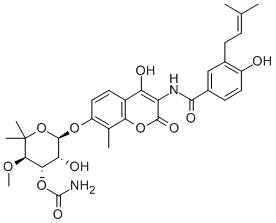
Novobiocin
- Product NameNovobiocin
- CAS303-81-1
- CBNumberCB4500553
- MFC31H36N2O11
- MW612.62
- EINECS206-146-3
- MOL File303-81-1.mol
- MSDS FileSDS
Chemical Properties
| Melting point | 170-172 °C |
| alpha | D24 -63.0° (c = 1 in ethanol) |
| Boiling point | 657.29°C (rough estimate) |
| Density | 1.3448 |
| refractive index | 1.5800 (estimate) |
| storage temp. | Hygroscopic, -20°C Freezer, Under inert atmosphere |
| solubility | DMSO (Slightly), Methanol (Slightly) |
| pka | pKa1 4.3; pKa2 9.1(at 25℃) |
| form | Solid |
| color | White to Pale Yellow |
| FDA 21 CFR | 556.460; 558.415; 558.4 |
| NCI Dictionary of Cancer Terms | novobiocin |
| FDA UNII | 17EC19951N |
Safety
| Symbol(GHS) |

|
| Signal word | Warning |
| Hazard statements | H302-H317 |
| Precautionary statements | P280-P301+P312+P330 |
| WGK Germany | 3 |
| HS Code | 2941906000 |
| Hazardous Substances Data | 303-81-1(Hazardous Substances Data) |


